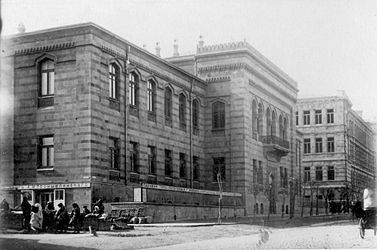Empress Alexandra Russian Muslim Boarding School for Girls
| Empress Alexandra Russian Muslim Boarding School for Girls | |
|---|---|
 A picture of Empress Alexandra Russian Muslim Boarding school for Girls | |
 | |
| General information | |
| Location | Baku, Azerbaijan, Istiglaliyyat Street |
| Coordinates | 40°23′43″N 49°52′55″E / 40.3952°N 49.882°E |
| Construction started | 1901 |
| Completed | 1918 |
| Design and construction | |
| Architect(s) | Specialists of “Bakinskiy rabochiy” (Baku worker) machinery plant |
The Empress Alexandra Russian Muslim School for Girls (
History

Despite what might seem to have been a project worthy of much praise, Zeynalabdin Taghiyev had great difficulty in gaining permission to open the school. He met with vigorous resistance; both from the Imperial
The architectural style of the boarding school was designed by
The school hence officially opened on September 7, 1901, and welcomed 58 females students, of whom 35 came from working-class families. The congratulatory telegramme sent to the students by the Empress put an end to all the opposition on both official and public level. Taghiyev also received congratulatory messages from scholars of Saint Petersburg, Kazan, Crimea, and Central Asia.
The students were taught
The pioneer project provoked Muslim communities in other parts of the Russian Empire to establish similar institutions. By 1915, in Baku alone there were five schools for Muslim girls.[1]
Notable staff
- Hanifa Malikova, wife of Hasan bey Zardabi, became the first principal of the school
- Maryam Sulkiewicz
- Sakina Akhundzadeh, playwright, was amongst the first set of teaching staff.[2] She started a drama group here.
- Asmiyasoltan Hafiz Mammad Amin qizi[3]
Modern usage
The school functioned until the fall of the Empire in 1918. In the 1920s it was reorganized into a teachers college, after 1930 it served as headquarters for various government institutions until finally it became the Institute of Manuscripts of the
-
Building of the school in pre-revolutionary Baku
-
Building of the Institute of Manuscripts of theNational Academy of Sciences of Azerbaijan, 2010
Gallery
-
Pupils and teachers. 1902
-
Embroidery lessons.
-
Alimardan Topchubashovwith pupils
-
Embroidery lessons. 1911
-
Lessons at school, in 1911. "The first Tatar school" is written on the blackboard. (Azerbaijanis were called Tatars in the beginning of the 20th century.)
-
Hanifa Malikova - principal of the school among pupils
References
- ^ The Past Days Archived 2007-03-22 at the Wayback Machine by Manaf Suleymanov. 1990
- ^ Azeri Women in Transition: Women in Soviet and Post-Soviet Azerbaijan By Farideh Heyat 2002 Routledge. Retrieved 20 October 2007
- ^ [1]. Echo. 7 March 2012.
- ^ Huseyn Javid: Exposition Archived 2007-09-06 at the Wayback Machine. Huseyncavid.com. Retrieved 24 March 2007
External links
![]() Media related to Empress Alexandra Russian Muslim Boarding School for Girls at Wikimedia Commons
Media related to Empress Alexandra Russian Muslim Boarding School for Girls at Wikimedia Commons








